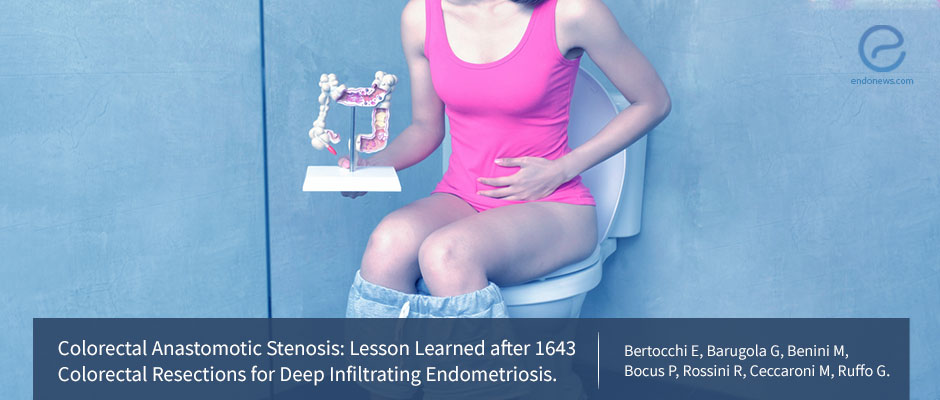Stenoses in the colorectal anastomose sites after DIE surgery
May 30, 2018
Anastomotic stenosis following colorectal resection of deep infiltrating endometriosis
Key Points
Highlights:
- The colorectal anastomotic stenosis, a complication after bowel resection for deep infiltrating endometriosis can be treated with endoscopic dilatation.
- This article evaluates the incidence, risk factors and treatment modalities of colorectal stenosis following the colorectal resection of deep infiltrating endometriosis (DIE).
Importance:
- The colorectal stenosis encountered following DIE surgery is a complication that reduces the quality of life. The presence of ileostomy and prior pelvic surgery are significant predictors for anastomotic stenosis.
- Endoscopic dilatation is a successful treatment option which is well-tolerated by patients, cost-effective and it is a reusable method.
What’s done here?
- This original article reviews 1643 women who underwent laparoscopic intestinal resection for DIE.
- One hundred and four patients with symptomatic anastomotic stenosis suffering from constipation, tenesmus, need to push, or ribbon stools were successfully treated with endoscopic dilatation.
Key results:
- Symptomatic anastomotic stenosis occurred in 104 patients (6.3% of all patients) who underwent colorectal resection for DIE.
- The presence of ileostomy and prior pelvic surgery were accepted as significant predictors for anastomotic stenosis.
- Treatment of anastomotic stenosis was conservative and endoscopic dilatation performed successfully, without any complication.
- Among them, ninety patients required three endoscopic dilatations. More than three sessions were needed in 13 patients.
- After the stenosis treatment, no recurrence was observed at 12-month follow-up.
Limitations
- Comorbidities such as diabetes, hypertension, clotting problems, obesity were not evaluated in the study.
- Three months follow-up may be considered as a short time for asymptomatic anastomotic stenosis after colorectal resection for DIE.
Lay Summary
Deep infiltrating endometriosis (DIE) is a particular form of endometriosis that penetrates at least 5 mm under the peritoneal surface. DIE is primarily located in the rectosigmoid junction and the rectum with an incidence of 70% and 90%, respectively. The most preferred treatment modality for DIE is laparoscopic resection of colorectal endometriotic nodules.
Following this procedure, anastomotic stenosis is a well-recognized complication.
Bertocchi et al, a group of scientists from Sacred-Heart- Don Calabria Hospital in Italy, published an article titled as “Colorectal Anastomotic Stenosis: Lesson Learned After 1643 Colorectal Resections for Deep Infiltrating Endometriosis” in the Journal of Minimally Invasive Gynecology. These authors focused on the incidence, risk factors and treatment modalities of colorectal stenosis following the colorectal resection of DIE.
They analyzed 1643 women who underwent laparoscopic colorectal resection for DIE between 2002 and 2016. Of these, 104 patients (6.3%) consulted with symptoms such as constipation, tenesmus, need to push, or ribbon stools suggesting anastomotic stenosis.
According to the statistical analysis, the only significant predictors for anastomotic stenosis were the presence of ileostomy and prior pelvic surgery.
All these patients were treated with endoscopic dilatation successfully. Only 90 patients required three endoscopic dilatations. More than three sessions were only needed in 13 patients. After this procedure, patients were followed for 12 months and no recurrent stenosis occurred during this period. None of the patients necessitate reoperation.
The authors concluded that follow-up with careful clinical evaluation is important to diagnose anastomotic stenosis after colorectal resection for DIE.
"When diagnosed, endoscopic dilatation is a successful treatment modality and should be preferred as the first option", they added.
Research Source: https://www.ncbi.nlm.nih.gov/pubmed/29678755
colorectal surgery endometriosis endoscopic dilatation laparoscopy DIE constipation tenesmus need to push ribbon stools

